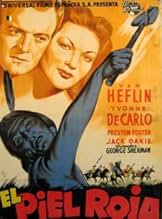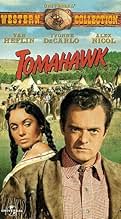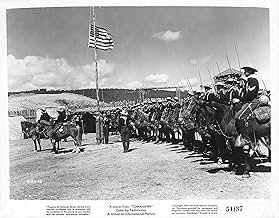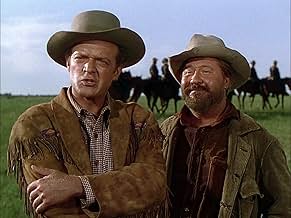VALUTAZIONE IMDb
6,4/10
1190
LA TUA VALUTAZIONE
Nel Wyoming del 1866, un esploratore di frontiera cerca di impedire una guerra tra i Sioux e gli Stati Uniti dopo che l'esercito ha costruito una strada e un forte sul territorio precedentem... Leggi tuttoNel Wyoming del 1866, un esploratore di frontiera cerca di impedire una guerra tra i Sioux e gli Stati Uniti dopo che l'esercito ha costruito una strada e un forte sul territorio precedentemente ceduto ai Sioux con un trattato.Nel Wyoming del 1866, un esploratore di frontiera cerca di impedire una guerra tra i Sioux e gli Stati Uniti dopo che l'esercito ha costruito una strada e un forte sul territorio precedentemente ceduto ai Sioux con un trattato.
- Regia
- Sceneggiatura
- Star
Russ Conway
- Maj. Horton
- (as Russell Conway)
Chief American Horse
- Indian
- (non citato nei titoli originali)
Sheila Darcy
- Woman
- (non citato nei titoli originali)
Abner George
- Man
- (non citato nei titoli originali)
James A. Hermstad
- Man
- (non citato nei titoli originali)
Recensioni in evidenza
Interesting western in that for a 1951 film, the white men for the major part are cast as the villains of the piece, continually ignoring earlier treaties with the Sioux and initiating aggressions that we understand will cause the Sioux to react aggressively themselves. The script also introduces a number of historical figures and incidents into the storyline, though plenty of liberties are taken with this "timeline" to ensure a smooth and dramatic narrative. Van Heflin was a good choice to play mountain man Jim Bridger, a real life character (who pops up in The Revenant) although he is roughly 20 years younger in the film's set time period, than he actually would have been. Engaging too, to note his character doesn't wear a gun and I'm pretty sure doesn't fire a weapon throughout this film. I feel the movie had one or two sub-plots too many, though I would have appreciated seeing more made of the somewhat enigmatic Monahseetah character who accompanies Bridger in a supposedly platonic relationship. Pleasing to see a number of native Americans playing indians, (though not in Monahseetah's case). A final word is needed to reassure potential viewers that the film looks a treat in colour, even though apparently its budget wasn't large by any means.
Battle of Powder River (AKA: Tomahawk) is directed by George Sherman and adapted for the screen by Sylvia Richards & Maurice Geraghty from a story by Daniel Jarrett. It stars Van Heflin, Yvonne de Carlo, Alex Nicol, Preston Foster, Jack Oakie, Tom Tully, John War Eagle and Susan Cabot. It's a Technicolor production filmed on location in the Black Hills of Dakota, with music by Hans J. Salter and photography by Charles P. Boyle.
"This is the Laramie Conference. A powder keg that may explode at any moment. It would take little to light the fuse. There are important and powerful men here. On one side the leaders of the Sioux nation-on the other representatives of the United States. But on this day it will take a great man to see both sides-Jim Bridger: pioneer, trapper and scout, is such a man."
Coming a year after Delmer Daves' excellent and similarly themed Broken Arrow, Battle of Powder River appears to have been lost in the mix of Westerns sympathetic to the Indians. Much like Broken Arrow, and for that matter Devil's Doorway (1950) as well, this is propelled by a magnetic and strong central lead performance. Van Heflin as Jim Bridger gives the film a believability factor, important for a film that's based around historical events in Montana Territory 1876/7. Thankfully the film built around Heflin isn't too bad either. The plot essentially involves Bridger, a man who married a Cheyenne woman, caught in the middle of an impending war between the Indians and the American military. The army are ordered to build a road and fort on land previously ceded to the Sioux by a previous treaty. This they want to do because of gold having been discovered in the Dakota's. Bridger sets about trying to keep peace but is undermined by personal conflicts and violent bigots like Lieut. Rob Dancy (and effective rascal turn by Alex Nicol).
Naturally for a film of this type, budget, era and running time, it's not an actual history lesson, so folk should not expect as such. But the makers are thoughtful as regards the events of the time and neatly tell their story via the fluctuating perspectives of the characters standing either side of the brewing conflict. It's also nicely shot by Sherman (The Battle at Apache Pass/Comanche) and Boyle (Horizon's West/Gunsmoke), the location work integral to the plot so as to understand what these people were ultimately fighting for. While Salter scores it in standard Cavalry Vs Indians style. The minor problems come with de Carlo's character and the shortness of the action. The former, admittedly lovely in Technicolor, serves only as romantic surplus who does a real dumb thing, and the latter is annoying since Sherman was more than capable of crafting exciting action (for example see the finale of The Battle at Apache Pass). Here the final battle of the title is swift and basically a compilation of charge and be felled sequences, while a buffalo scene is all too brief and only hints at what excitement could have been garnered from that passage of play. Annoyances for sure, but not enough to drag the piece down to B movie fodder territory.
Although it's trumped by two, thematically similar and better movies the previous year, the story, Heflin and the scenery make this a must see for the Western fan. 7.5/10
"This is the Laramie Conference. A powder keg that may explode at any moment. It would take little to light the fuse. There are important and powerful men here. On one side the leaders of the Sioux nation-on the other representatives of the United States. But on this day it will take a great man to see both sides-Jim Bridger: pioneer, trapper and scout, is such a man."
Coming a year after Delmer Daves' excellent and similarly themed Broken Arrow, Battle of Powder River appears to have been lost in the mix of Westerns sympathetic to the Indians. Much like Broken Arrow, and for that matter Devil's Doorway (1950) as well, this is propelled by a magnetic and strong central lead performance. Van Heflin as Jim Bridger gives the film a believability factor, important for a film that's based around historical events in Montana Territory 1876/7. Thankfully the film built around Heflin isn't too bad either. The plot essentially involves Bridger, a man who married a Cheyenne woman, caught in the middle of an impending war between the Indians and the American military. The army are ordered to build a road and fort on land previously ceded to the Sioux by a previous treaty. This they want to do because of gold having been discovered in the Dakota's. Bridger sets about trying to keep peace but is undermined by personal conflicts and violent bigots like Lieut. Rob Dancy (and effective rascal turn by Alex Nicol).
Naturally for a film of this type, budget, era and running time, it's not an actual history lesson, so folk should not expect as such. But the makers are thoughtful as regards the events of the time and neatly tell their story via the fluctuating perspectives of the characters standing either side of the brewing conflict. It's also nicely shot by Sherman (The Battle at Apache Pass/Comanche) and Boyle (Horizon's West/Gunsmoke), the location work integral to the plot so as to understand what these people were ultimately fighting for. While Salter scores it in standard Cavalry Vs Indians style. The minor problems come with de Carlo's character and the shortness of the action. The former, admittedly lovely in Technicolor, serves only as romantic surplus who does a real dumb thing, and the latter is annoying since Sherman was more than capable of crafting exciting action (for example see the finale of The Battle at Apache Pass). Here the final battle of the title is swift and basically a compilation of charge and be felled sequences, while a buffalo scene is all too brief and only hints at what excitement could have been garnered from that passage of play. Annoyances for sure, but not enough to drag the piece down to B movie fodder territory.
Although it's trumped by two, thematically similar and better movies the previous year, the story, Heflin and the scenery make this a must see for the Western fan. 7.5/10
Just found a video of Tomahawk at a yard sale. The filming itself was beautiful in glorious Technicolor! If you are a Western fan you will like this one, so give it a watch if you have the opportunity. Van Heflin played Jim Bridger the famous mountain man and scout. Mr. Heflin was a wonderful actor, but I think I would have chosen someone else to play the legendary Bridger. He just didn't seem rough and tough enough for the part. Maybe he did such a good job in Shane that I type cast him myself. Still, he did a very good acting job in this one. Good old Jack Oakie was the side kick and added the light touch of humor. His acting experience was always welcome in any movie. Another great character actor, Tom Tully, ran a traveling medicine type wagon show with Yvonne De Carlo as his assistant. I don't remember seeing her lovelier. Preston Foster as the always reliable man in charge as the commander of the fort. Alex Nicol played his part well as the bad guy (who kills Indians from hate). An early bit part for Rock Hudson as Hanna. By the look on his sleeve he was a corporal. Watch fast or you will miss him. Ann Doran was Preston Foster's wife Mrs. Col. Carrington, always a reliable actress (remember her as James Dean's mother in Rebel Without A Cause?) The very lovely Susan Cabot played an Indian girl who travels with Jim Bridger since her family was killed by the Chivington gang (Susan was murdered in 1986 by her son who suffered from dwarfism). Red Cloud was played very ably by John War Eagle. He was a veteran of many movies and TV work, mostly westerns such as Winchester 73, Annie Get Your Gun with Betty Hutton, Sgt. Preston, Annie Oakley, Buffalo Bill Jr, Roy Rogers show, etc. Capt. Fetterman was played by Arthur Space a long time character actor along with Russell Conway as Major Horton another great character actor. It is just a good old fashioned Western with plenty of action. Don't worry about historical facts or get caught up in the old treatment of Native Americans debate. We are all aware that the Indians got a raw deal in many a treaty and that white, black and red people were murdered without reason. The movie is meant to entertain. Let it do its job and just enjoy the movie for what it is. Well worth watching!
George Sherman and Universal studios were used to this kind of western, colourful and action packed. Remember BATTLE AT APACHE PASS, WAR ARROW, COMANCHE TERRITORY. And here Van heflin and Yvonne De Carlo's presence help a lot in the powerful quality of this film where character depiction is also important. It is definitely a pro Indian film, in the line of BROKEN ARROW, and there will be many of those pro Indian westerns, shot in superb locations and settings. Alex Nicol is an exquisite rotten cavalry officer and Preston Foster is also excellent. I highly advise it to western buffs. Made in 1951.
It's 1866 in the Wyoming territory, and the US government is trying to forge a treaty with the Sioux for access through the region to gold-rich Montana. The natives reluctantly agree thanks to the intervention of white friend-to-the-Indian Jim Bridger (Van Heflin). The army sets up a new fort to protect the trail, and Bridger agrees to work as a scout for them, but he has a secret ulterior motive. Things at the fort get more complicated when traveling entertainer Julie Madden (Yvonne De Carlo) is forced to take shelter there.
This was a rare sympathetic portrayal of Native Americans for the time, depicted as a noble people continuously mistreated by the US government yet hopelessly outmatched and with nothing but the end to look forward to. There's also a compelling plot involving revenge for a long-ago injustice. Unfortunately, not a lot really happens in the movie, and what does happen is very predictable. De Carlo, once again looking ravishing, has little to do, and only serves a single purpose in the plot. Jack Oakie is also wasted as a fur-trapper companion to Heflin
This was a rare sympathetic portrayal of Native Americans for the time, depicted as a noble people continuously mistreated by the US government yet hopelessly outmatched and with nothing but the end to look forward to. There's also a compelling plot involving revenge for a long-ago injustice. Unfortunately, not a lot really happens in the movie, and what does happen is very predictable. De Carlo, once again looking ravishing, has little to do, and only serves a single purpose in the plot. Jack Oakie is also wasted as a fur-trapper companion to Heflin
Lo sapevi?
- QuizA bearded Rock Hudson is barely recognizable, except perhaps by his voice, until he gets a relative close-up an hour and six minutes into the film. Up to that point, he is further away from the camera.
- BlooperWhen Dancy is shot and killed by an arrow, padding can clearly be seen beneath his shirt.
- Citazioni
Dan Castello: I have to keep moving. Got iron in my blood. If I sit still, I rust.
- Versioni alternativeAccording to Wikipedia, Tomahawk was originally released in the UK under the title "Battle of Powder River". The reference for this is given as Monthly Film Bulletin, 18 (204), London, January 1, 1951, p. 217 and google searches return images of movie posters in that name. The title is erroneous, however, as the real Battle of Powder River took place just over the border, in Montana, in 1876, ten years after the events depicted in Tomahawk.
I più visti
Accedi per valutare e creare un elenco di titoli salvati per ottenere consigli personalizzati
- How long is Tomahawk?Powered by Alexa
Dettagli
Botteghino
- Budget
- 750.000 USD (previsto)
- Tempo di esecuzione1 ora 22 minuti
- Proporzioni
- 1.33 : 1
Contribuisci a questa pagina
Suggerisci una modifica o aggiungi i contenuti mancanti


































